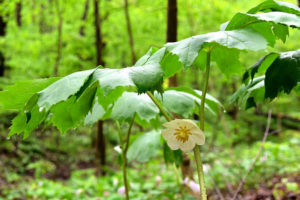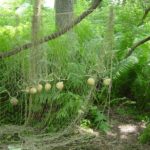Well, that goes for unripe fruit at least…
You have heard me say it before and I will say it again here – plants are toxic. In fact, plants put a lot of effort and energy in creating toxins to protect themselves and to keep other life at a distance. But, that isn’t the whole story. Plants aren’t entirely evil nor are they utterly recluses. Throughout the 700 million years plants have existed on earth they have co-evolved with other life. Sure, much of this evolution caused them to create defense mechanisms in the form of toxins to keep bacteria, fungi, and hardcore herbivores away. But, somewhere along the line plants also realized that forming relationships with other life could actually benefit them, much like an anemone and a clownfish (come on, we all have seen Finding Nemo, right?). The most important symbiotic evolution in the plant world took place during the early part of the Cretaceous Period (125 – 66 million years ago).
Pollinators and Flowering Fruits
A perfect example is the co-evolution of flowering plants and the pollinators that 86% of them require for reproduction. It should be no surprise that they both appear together on earth at the same time. The earliest identified flowering plant, or angiosperm, is the Archaefructus and appears in the fossil record about 125 million years ago. To date, the earliest identified pollinator insects, thysanoptera, date to 110 million years ago and were recovered from amber found in Northern Spain. Equally important, is the relationship between fruits and frugivores. The first frugivore is a bird called Jeholornis, which lived about 120 million years ago. Paleontologists have not yet recovered fruit that dates back that early (the earliest direct evidence for fruit, a member of the Physalis genus only dates to 52 million years ago) but believe that fruit bearing plants have been around since the beginning of the Cretaceous.
So, what gives? And, what does any of this have to do with human diet and health?
Flowers benefit by attracting insects to pollinate them and fruits benefit by attracting animals who eat the fruits and carry away the seeds later depositing them in a rich pile of manure. Plants actually put a lot of effort into creating chemical compounds to attract pollinator insects to the flowers and frugivores to their fruits. That is why flowers and fruits typically look pretty, smell good and taste delicious! It also means that compared to other parts of the plants flowers and fruits are often not toxic.
Hold on.
Hold on.
That isn’t entirely true.
Let me qualify that statement… flowers and RIPE fruits are generally not toxic.
The dangers of fruit
We humans have to be very careful when consuming fruits and keep two things in mind. First, seeds are the plants’ progeny and are often highly protected by toxins. In fact, they are physically and chemically designed to withstand the digestive tracts of frugivores. And, second, unripe and ripe fruits are entirely different things. Since unripe fruits contain seeds that have not fully matured the plants do not want them eaten yet. As a result, unripe fruits are not only not as visually appealing, smell as good, nor taste as good as ripe fruit, many of them are actually toxic!
This is true for most fruits. For example, website Frugivore states, “Bananas, plums, citrus, and countless other fruits contain harmful compounds before they are fully ripe. Some of these may cause negligible to minor symptoms, while some can be more serious.” There are also many more extreme examples.
- For instance, the unripe ackee fruit contains a poison, hypoglycin. Consuming this can lead to Jamaican vomiting sickness and can be fatal.
- Unripe lychee fruits also contain the same hypoglycin toxin.
- Unripe Elderberries contain high concentrations of alkaloids and lectins.
- And, unripe papaya contains papain. Consumption of papain can damage the esophagus and, if you are pregnants can cause birth defects.
- Green tomatoes (yes, tomatoes are a fruit!) contain alkaloids tomatine and solanine which can cause headaches, dizziness, diarrhea, and cramping.
This list just scratches the surface. Believe me, unripe fruits are dangerous. And, it is fully intentional on the plant’s part.
When are fruits safe to eat?
On the other hand, when most fruits ripen they can become the least toxic part of the plant. When the seeds are mature and ready for dispersal many plants switch off the toxins in the fruit and transform them into safe and delicious forms of pleasure and nutrition for animals (including humans). This is a lesson I relearned annually since I started foraging 40 years ago. And, I finally had closure last week…
The elusive may apple
I have lived my entire life (except for the one year our family lived in Ireland) within the range of the American Mandrake, AKA Mayapple (Podophyllum peltatum). Each spring this unique looking plant blankets the forest floor of Eastern North America with little umbrella looking leaves. It then produces a beautiful white flower which is pollinated by bumblebees and other bees with long tongues and eventually forms a small green fruit. This plant contains powerful toxins known as alpha-peltatin, beta-peltatin and the glucoside, podophyllotoxin. Eating any part of this plant including the roots, stem, leaves, seeds and unripe fruit is extremely dangerous. It is so dangerous, in fact, after eating mayapple foliage, roots, unripe fruit or seeds our body does everything it can to get rid of the toxin as quickly as possible including inducing peristalsis (a series of wave-like muscle contractions that move food through the digestive tract), severe purging gastroenteritis (diarrhea), vomiting, and drooling! And, yes, if the body is unable to purge itself sufficiently, you die.
I’ve been waiting for 40 years
Over the past 40 years I have watched the Mayapple emerge from the ground, form a flower and produce a fruit. And, each year I have waited patiently for it to ripen so that I could try it. In fact, there are some years where I would visit the same plants literally every day in anticipation of a mature fruit. But, every single year other animals would beat me to the ripe fruits and I would leave my Mayapple patch disappointed year after year. That is, until this year.
I was relaying this story at the Modern Stone Age Kitchen earlier in the spring and one of our team members, Jeff, said he had mayapples growing in his yard and he promised me he would bring me some ripe fruits. He literally built a fence around some mayapple plants to keep the animals away and came through on his promise – two weeks ago he brought me some almost ripe fruits! We waited patiently as they finished ripening upstairs in the Eastern Shore Food Lab and even used them as a prop in the interview with Lilly Kane for YouTube to illustrate some important points. Then, finally, they ripened. The time to taste them finally arrived!
I asked Jeff if he wanted to join me and he enthusiastically said, “Yes!” Christina joined us upstairs with her phone in hand to film. After all, there is no way we could risk missing our reactions if this fruit turned out to be delicious! I have to admit they looked good and smelled delicious. I was so excited! We cut them open and scraped out the seeds (remember, they are still poisonous) and then lifted the flesh to our mouths.
Forty years of anticipation were finally over. We tasted the fruit and watch below to see what happened!
Take-aways
Unfortunately, it really wasn’t that good. I was truly disappointed that I had built this up in my mind to the point I had. But, I was equally elated to have finally tried something I had waited so long for. Jeff, thank you so much for helping make the elusive mayapple fruit not so elusive.
So, what’s the moral of this story? Well, there are two.
First, don’t eat unripe fruits. There are a lot of arguments for and against fruit as a part of a healthy human diet. And, both sides make good points which we will tackle in future blog posts. However, they don’t apply to unripe fruits. From a biological perspective unripe fruits are simply not meant to be eaten.
Second, leave the Mayapples alone. They just aren’t worth it.





 The most dangerous cheese in the world
The most dangerous cheese in the world
Leave a Reply